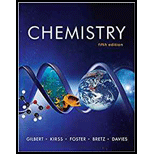
(a)
Interpretation: The given net ionic equations are to be balanced and the elements that are oxidized and reduced are to be identified.
Concept introduction: Oxidation is a process in which there is a loss of electron during a reaction.
Reduction is a process in which there is a gain of electron during a reaction.
In ionic equation the individual ions of the constituent compound are shown.
The reaction is balanced when the number of atoms and charge are balanced on the both sides of the reaction.
To determine: The balanced net ionic equation and the identification of the elements that are oxidized and reduced.
(a)
Answer to Problem 4.104QP
Solution
The balanced net ionic equation is,
Sulfur is oxidized and manganese is reduced in the reaction.
Explanation of Solution
Explanation
The given net ionic reaction is,
The reaction is balanced when the number of atoms and charge are balanced on the both sides of the reaction.
To balance the above equation, first number of atoms will be balanced.
The number of oxygen atoms is balanced by adding the coefficient
Four hydrogen atoms are present on the right hand side of the reaction. To balance the hydrogen atoms, coefficient
The balanced net ionic equation is,
The common oxidation number of oxygen is
The net charge on
The oxidation number of manganese in
The oxidation number of manganese in
Substitute the value of oxidation number in the above expression.
The oxidation number of manganese in
The oxidation number of manganese in
The net charge on
The oxidation number of manganese in
Substitute the value of oxidation number in the above expression.
The oxidation number of manganese in
The oxidation number of manganese has decreased from
Thus, manganese is reduced.
The oxidation number of sulfur increases from
(b)
To determine: The balanced net ionic equation and the identification of the elements that are oxidized and reduced.
(b)
Answer to Problem 4.104QP
Solution
The balanced net ionic equation is,
Iodine is both oxidized and reduced in the reaction.
Explanation of Solution
Explanation
The given net ionic reaction is,
The reaction is balanced when the number of atoms and charge are balanced on the both sides of the reaction.
To balance the above equation, first oxygen atoms are balanced by adding the coefficient
Now, the hydrogen atoms are balanced by adding
The balanced net ionic equation is,
The common oxidation number of oxygen is
The net charge present on
The oxidation number of iodine atom in
The oxidation number of iodine atom in
Substitute the value of oxidation number in the above expression.
The oxidation number of iodine atom in
The oxidation number of iodine atom in
Therefore, iodine in iodate ion
(c)
To determine: The balanced net ionic equation and the identification of the elements that are oxidized and reduced.
(c)
Answer to Problem 4.104QP
Solution
The balanced net ionic equation is,
Manganese is oxidized and bismuth is reduced in the reaction.
Explanation of Solution
Explanation
The given equation is,
The common oxidation number of oxygen is
The net charge on
The oxidation number of manganese in
The oxidation number of manganese in
Substitute the value of oxidation number in the above expression.
The oxidation number of manganese in
The oxidation number of manganese in
So, the oxidation number of manganese has increased from
The oxidation number of bismuth is calculated by the formula,
The oxidation number of bismuth is assumed to be
The net charge in
Substitute the value of oxidation number in the above expression.
The oxidation number of bismuth in
The oxidation number of bismuth in
So, the oxidation number is decreasing from
The above equation is not balanced.
To balance the equation, coefficient
First oxygen atoms are balanced by adding the coefficient
Then, hydrogen atoms are balanced by adding the coefficient
The balanced net ionic equation is,
Therefore, manganese is oxidized and bismuth is reduced in the reaction.
Want to see more full solutions like this?
Chapter 4 Solutions
CHEMISTRY:SCI.IN CONTEXT (CL)-PACKAGE
- For the reaction: CO2(g) + H2(g) --> CO (g) + H2O (g) Kc= 0.64 at 900 degrees celcius. if initially you start with 1.00 atmoshpere of carbon dioxide and 1 atmoshpere of hydrogen gas, what are the equilibrium partial pressuses of all species.arrow_forwardCan I please get this answered? With the correct number of significant digits.arrow_forwardDraw the Hofmann product of the dehydroiodination of this alkyl iodide. ☐ : + Explanation Check esc F1 2 3 I 88 % 5 F5 I. X © tBuOK Click and drag to sta drawing a structure. © 2025 McGraw Hill LLC. All Rights Reserved. Te BI BB F6 W E R Y S H Karrow_forward
- Can I please get help with this graph, if you could show exactly where it needs to pass through please.arrow_forwardDraw the condensed structure of 1,3-dihydroxy-2-pentanone. Explanation Check Click anywhere to draw the first atom of your structure. Х C © 2025 McGraw Hill LLC. All Rights Reserved. Terms of use +arrow_forward0.500 moles of NOCl are placed into a 1.00 L vessesl at 700K and after the system comes to equilibrium, the consentration of NOCl is 0.440 M. Calculate the equilibrium constant Kc for the reaction: 2NOCL (g) --> 2NO (g) + Cl2 (g)arrow_forward
 ChemistryChemistryISBN:9781305957404Author:Steven S. Zumdahl, Susan A. Zumdahl, Donald J. DeCostePublisher:Cengage Learning
ChemistryChemistryISBN:9781305957404Author:Steven S. Zumdahl, Susan A. Zumdahl, Donald J. DeCostePublisher:Cengage Learning ChemistryChemistryISBN:9781259911156Author:Raymond Chang Dr., Jason Overby ProfessorPublisher:McGraw-Hill Education
ChemistryChemistryISBN:9781259911156Author:Raymond Chang Dr., Jason Overby ProfessorPublisher:McGraw-Hill Education Principles of Instrumental AnalysisChemistryISBN:9781305577213Author:Douglas A. Skoog, F. James Holler, Stanley R. CrouchPublisher:Cengage Learning
Principles of Instrumental AnalysisChemistryISBN:9781305577213Author:Douglas A. Skoog, F. James Holler, Stanley R. CrouchPublisher:Cengage Learning Organic ChemistryChemistryISBN:9780078021558Author:Janice Gorzynski Smith Dr.Publisher:McGraw-Hill Education
Organic ChemistryChemistryISBN:9780078021558Author:Janice Gorzynski Smith Dr.Publisher:McGraw-Hill Education Chemistry: Principles and ReactionsChemistryISBN:9781305079373Author:William L. Masterton, Cecile N. HurleyPublisher:Cengage Learning
Chemistry: Principles and ReactionsChemistryISBN:9781305079373Author:William L. Masterton, Cecile N. HurleyPublisher:Cengage Learning Elementary Principles of Chemical Processes, Bind...ChemistryISBN:9781118431221Author:Richard M. Felder, Ronald W. Rousseau, Lisa G. BullardPublisher:WILEY
Elementary Principles of Chemical Processes, Bind...ChemistryISBN:9781118431221Author:Richard M. Felder, Ronald W. Rousseau, Lisa G. BullardPublisher:WILEY





